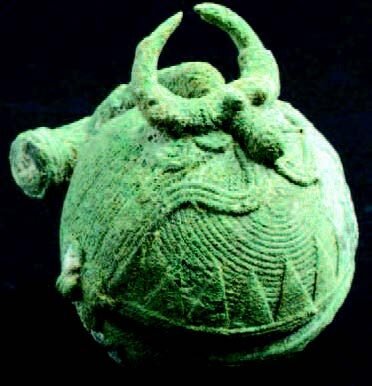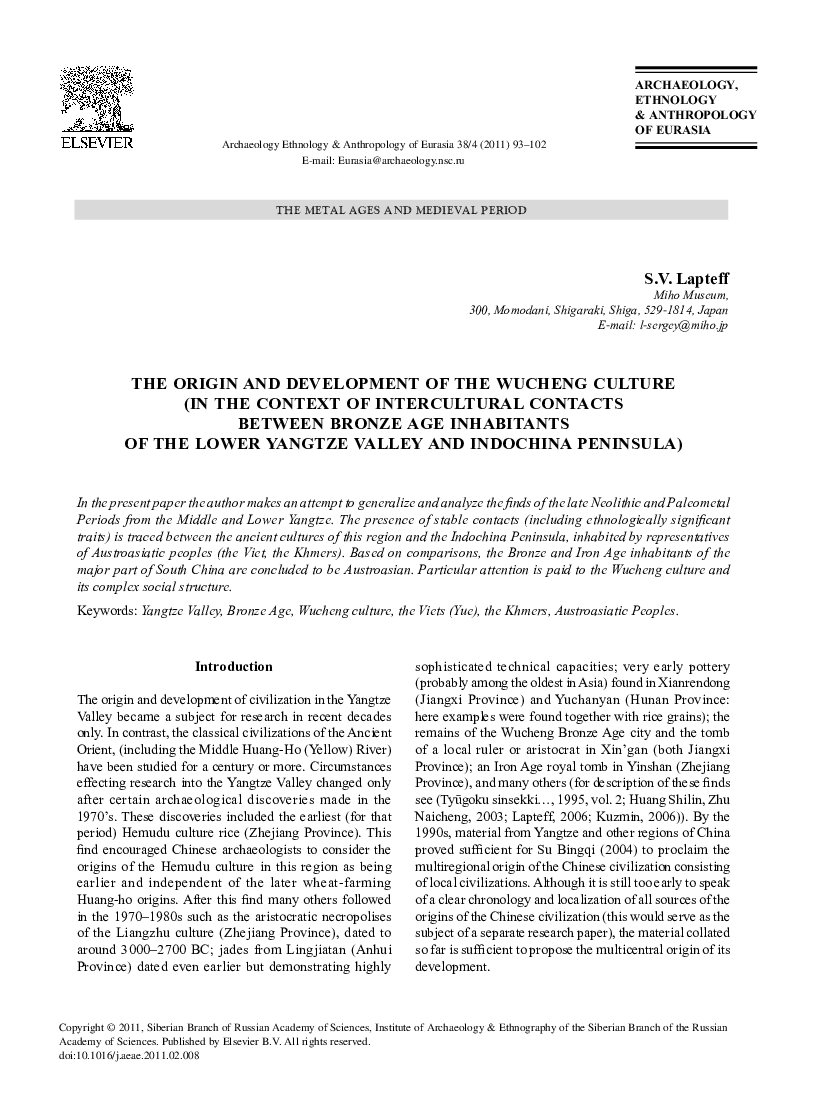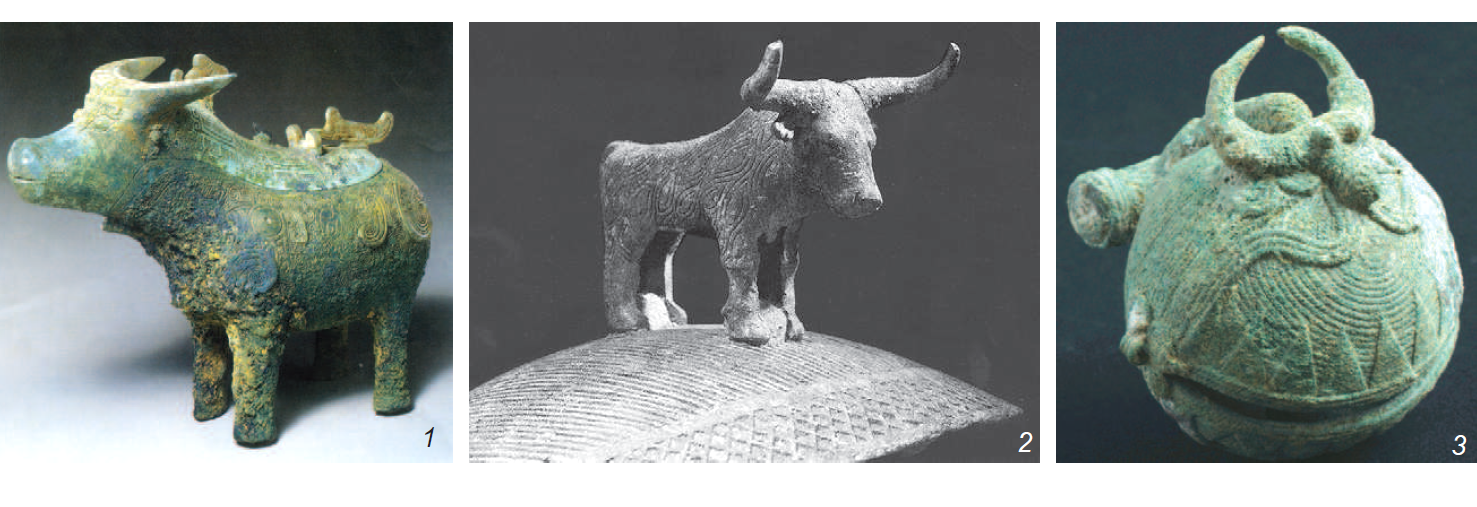The Origin and Development of The Wucheng Culture
by Sergey Lapteff
'In the Context of Intercultural Contacts Between Bronze Age Inhabitants of the Lower Yangtze Valley and Indochina Peninsula'.

- Publication
- Archaeology Ethnology & Anthropology of Eurasia 38/4, 93–102 | Published by Elsevier for Siberian Branch of Russian Academy of Sciences, Institute of Archaeology & Ethnography of the Siberian Branch of the Russian Academy of Sciences.
- Published
- 2011
- Author
- Sergey Lapteff
- Pages
- 10
- DOI
- 10.1016/j.aeae.2011.02.008
- Language
- English
pdf 984.1 KB
Drawing from the study of very early pottery (probably among the oldest in Asia) found in Xianrendong(Jiangxi Province) and Yuchanyan (Hunan Province), the remains of the Wucheng Bronze Age city and the tomb of a local ruler or aristocrat in Xin’gan (both Jiangxi Province), an Iron Age royal tomb in Yinshan (Zhejiang Province), and many others finds, this is an attempt to generalize and analyze archaeological evidence of the late Neolithic and Paleometal Periods from the Middle and Lower Yangtze.
Notes the author: “The presence of stable contacts (including ethnologically significant traits) is traced between the ancient cultures of this region and the Indochina Peninsula, inhabited by representatives of Austroasiatic peoples (the Viet, the Khmers). Based on comparisons, the Bronze and Iron Age inhabitants of the major part of South China are concluded to be Austroasian. Particular attention is paid to the Wucheng culture and its complex social structure.”
One example is the representation of water buffalo, “a very rare image in bronze found on the territory of China. The water buffalo played a special ritual role in the rites and beliefs of the ancient Viet people in Yangtze – North Indochina and the Khmer people in Cambodia. In the Central Plain, the water buffalo cannot survive. Although Shang ritual vessels bear reliefs of horned animals, these are made in a very abstract manner and their species cannot be clearly determined. The water buffalo should be clearly distinguished from the bull. These represent different species which had a totally different meaning in the minds of the Southeast Asian peoples. This fact can be evidenced by the ethnography of the modern Khmers. Several artifacts have been recorded depicting the water buffalo in the region of East and Southeast Asia. Except for a few finds to the south of Yangtze, the figure of the water buffalo as part of a vessel, relief or as a separate figurine, is widely represented in the Shizhaishan culture in Yunnan, and though its date is much later, around the 2nd half of the 1st millennium BC, the manner in which this animal is depicted is very similar to that of the figurine-vessel from the Miho Museum.”
Taking after earlier studies by Khmerologist Michel Tranet, the author asserts that “at least from the Bronze Age, the material culture in Cambodia developed successively through the Angkor period (9th – 15th c.) up to modern times; even the location of inhabited areas often coincides with locations of ancient settlements. According to M. Tranet, the modern Khmers are basically the same people as they were in prehistory only having experienced indianization. The origins of the Mon-Khmer people can most probably be found in Indonesia.” This hypothesis have been heatedly discussed by earlier ethnologists such as Georges Maspero or George Coedès.
As for the Wucheng culture, the author notes that it “perished probably due to military defeat. In the latest layers of the Wucheng city ruins the sculls of 21 individuals were found on the city rampart, supposedly young men, some with wounds, who were probably killed during combat. After this layer, not only did the Wucheng city site ceased to exist, but the Wucheng culture seems to totally disappear. The region was devastated. Hardly any bronze objects attributable to the next period, the first half of the 1st millennium BC, have been found. In the post-Wucheng (Zhou) period, this territory became a part of the Chu State, which spread here from the Dongtinghu Lake region in the Central Yangtze. In the 1st millennium BC, the Chu, Wu and Yue gradually accepted the Zhou culture of the Huang-ho people, their writing system, and some traditions, but at the same time, preserved their own peculiarities throughout this long period, very gradually becoming a part of the symbiotic “Han” culture. The Bronze Age culture of the Lower Yangtze region (Wucheng culture) shares similarities with quite distant Indochinese cultures and differs markedly from the Shang culture in Huang-ho. Its formation was influenced by the Liangzhu culture at the Yangtze mouth, but was based on the development of local agricultural communities. Proximity to natural sources of copper (ancient Tongling copper mines) also seems to represent an important factor in its rise and development.”
Photos: Figurines of water buffalo, 1 – Middle Yangtze Region, second half of the 2nd millenium BC, Miho Museum collection (after Miho Museum, 1997); 2 – Shizhaishan culture, Yunnan Province, 2nd half of the 1st millenium BC (after Dian 1986); 3 – Phum Snay, photograph by the author.
Tags: pottery, Yangtze, China, prehistory, protohistory, Phum Snay, Khmer-Mon, South China, ethnology, Bronze Age, prehistoric settlements
About the Author

Sergey Lapteff
Sergey Lapteff С. B. Лаптев is a researcher and archaeologist with the Miho Museum, Japan.
A graduate from the Maxim Gorky Institute of Literature, Moscow, Russia, he excavated Northwestern Cambodian sites in 2003 – 2007, and published about the findings.
Amongst his other publications: Jomon culture and the cultures of the Yangtze, South China and continental Southeast Asian areas (Japan Review, 2006) | Chinese Influence on the Technological Development of Yayoi Period Japan: Problems of Metal Casting and the Production of Bronze Mirrors.


